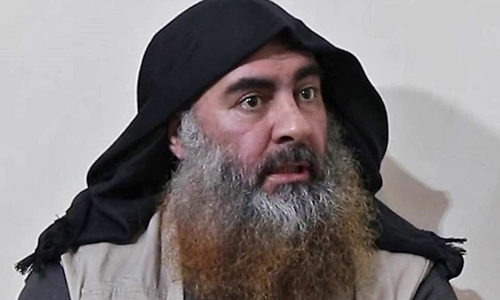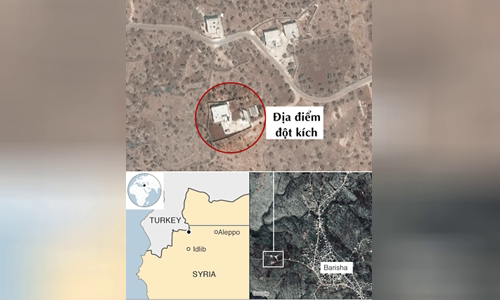Abu Bakr al-Baghdadi was so obsessed with security that he wore a suicide bomber belt during the last months of his life.
The Supreme Leader of the Islamic State group (IS), who called himself Abu Bakr al-Baghdadi, had kept a Yazidi girl as a slave for months before being killed in a raid in late October. Bring her along when moving with a group of about 7 confidants.

Abu Bakr al-Baghdadi in the video was released in April Photo: Independent
The Yazidi girl was rescued in a US-led raid in May. She said Baghdadi initially tried to flee to Idlib in late 2017. The then 17-year-old girl was put on a convoy of three leaders. IS, his wife and the guards are on Idlib's side. But when the main road, the convoy suddenly turned, seemingly afraid of being attacked.
For about a week, they stayed in the town of Hajin, southeastern Syria, near the Iraqi border. They then moved north to Dashisha, a Syrian border town in the area of IS.
There, the young Yazidi spent four months in the home of al-Baghdadi's father-in-law, Abu Abdullah al-Zubaie. Baghdadi often came to rape her, sometimes beating her. He only moves at night, wearing sneakers and covering his face, there are always about 5 bodyguards to follow.
"He never answered my questions because he was worried about security risks. Not everyone knows where he is," she said.
In the spring of 2018, she was given to another man who removed her from Dashisha. That was the last time she met al-Baghdadi and he gave her a piece of jewelry.
Baghdadi moved several times in eastern Syria this year, when IS repeatedly lost the stronghold to the hands of US-backed Kurdish forces. He arrived in Idlib in the spring of 2019.
Baghdadi's residence when raided in October. Graphic: BBC.
Baghdadi is always in a state of tension, worried about having a betrayal or spying junior, Mohamad Ali Sajit, a brother of the IS leader, said in an interview with Al-Arabiya TV that was broadcast in the week. before.
Sajit was captured by Iraqi authorities in June. He claimed to have met al-Baghdadi several times over the course of 18 months, starting in Hajin in late 2017. The last time was in the desert region along the Syrian-Iraq border long before Sajit was arrested. Baghdadi has assigned Sajit to transfer USB containing information to juniors in Iraq.
Kurdish officials in Iraq and Syria have exploited separate sources to locate IS and Sajit leaders, one of them. A US official said the Syrian Kurds seem to have found a "visitor" within Baghdadi's close circle that could provide vital information.

Baghdadi's residence when raided in October Photo: BBC
Sajit explained that IS lost many areas, so Baghdadi also had limited range. He always wears suicide bombs, even keeps them close to bed, and also asks his aide to wear them. Baghdadi never uses a mobile phone.
Stressful mood made Baghdadi's diabetes worse, he had to constantly monitor blood sugar and use insulin. He did not fast during Ramadan (Muslims must not eat or drink during the day) and also forced his aides to follow.
Baghdadi sometimes disguises himself as a shepherd. When the head of Baghdadi's bodyguards, Abu Sabah, received the news that they were at risk of a raid in the desert on the Syrian-Iraq border, they took down the tent and hid Baghdadi in a pit and took the sheep. crater for more camouflage.
Baghdadi moved with a confidant circle of 5-7 people, including al-Muhajer, al-Zubaie, Abu Sabah and Abu al-Hakim, who had been the group's leader in Iraq. Al-Muhajer was annihilated the same day as Baghdadi, in a separate US-led military campaign in northwest Syria. Al-Zubaie was killed during the raid in March. Earlier this week Turkish officials said they arrested Baghdadi's sister in Azaz, northwestern Syria. All are areas outside the control of the government.
The IS leader has entrusted a lot of power to leading Hajji Abdullah. Iraqi officials say Baghdadi has left Abdullah in charge of most of the group's administrative and financial affairs. Sajit believes Hajji Abdullah is Baghdadi's successor, taking the new name Abu Ibrahim al-Hashemi Al-Qurayshi.
US officials do not know exactly when Baghdadi arrived in Idlib, but said he chose the location because it was the last land outside the control of the Syrian government. According to the Kurdish forces, he may have been there by the end of March.
There, he hid in a block of houses in Barisha village, about 5 km from the Turkish border. Like many of Idlib's border towns, the village has many migrants from all over Syria and is controlled by Hayat Tahrir al-Sham, a militant group linked to al-Qaeda and an IS rival.
The estate belongs to sheep-dealer Abu Mohammed al-Halabi, with little interaction with neighbors. A local resident said that nearly a dozen helicopters danced in their village before 11pm on October 26 during the US raid. When US special forces chased Baghdadi in the bunker, he activated a suicide bomb belt, killing himself and the two children.
"We went out to the balcony to see and they started firing. We immediately ran inside to hide," the person said. "Later, Americans warned residents to stay away from al-Halabi's house because they would blow it up."
"No one thought al-Baghdadi was there," another local resident said.



 DavidKennewell
DavidKennewell







